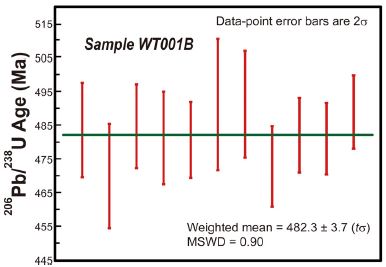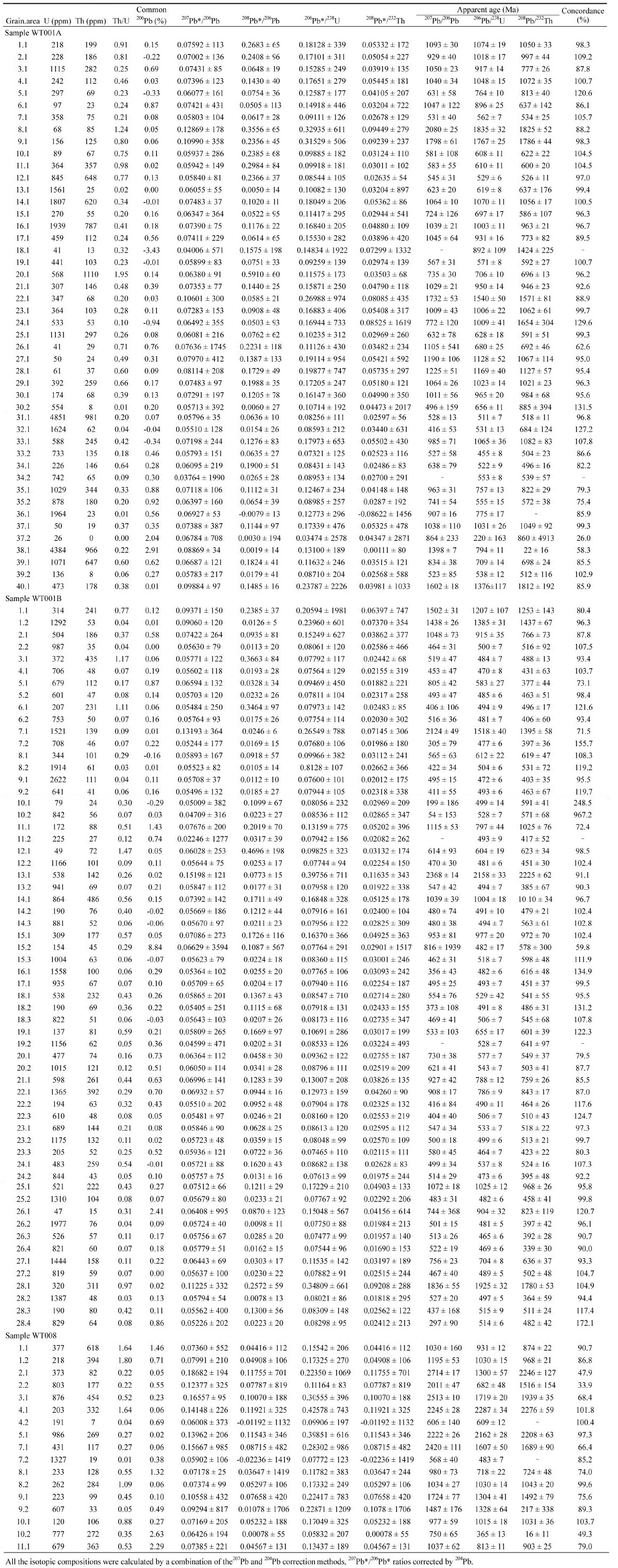
남극 북빅토리아랜드 윌슨 암체 호상 편마암과 우백질 암맥의 저어콘 SHRIMP U-Pb 연령
Copyright © 2017 The Geological Society of Korea
This is an Open Access article distributed under the terms of the Creative Commons Attribution Non-Commercial License (http://creativecommons.org/licenses/by-nc/3.0/ which permits unrestricted non-commercial use, distribution, and reproduction in any medium, provided the original work is properly cited.
초록
남극 북빅토리아랜드의 윌슨 암체는 주로 선캠브리아기-초기 캠브리아기 모암의 중-고 변성도 변성퇴적암과 캠브리아기-오르도비스기 심성암으로 이루어져 있으며, 로스 조산운동 시기에 북동쪽의 바우어스, 로버트슨 베이 암체와 병합되어 북빅토리아랜드를 형성한 것으로 알려져 있다. 윌슨 암체 변성퇴적암류의 변성작용 시기 제한 및 퇴적물 기원지 해석을 위해 2개의 호상 편마암과 이를 관입하는 1개의 우백질 암맥 시료에서 수집한 저어콘 결정들에 대해 고분해능 이차이온질량분석기를 이용하여 U-Pb 성분 분석을 실시하였다. 화성 기원의 오르도비스기 연령을 제외하면 시료 전체의 저어콘 U-Pb 연령 분포는 각각 그렌빌 및 판아프리카 조산운동 시기인 ~1.0-1.2 Ga와 ~530-700 Ma 범위에 집중되며, 1.6 Ga 이상에서는 산재되어 있고 신원생대 초-중기(~700-900 Ma)에서 결여된 특징을 보인다. 호상 편마암 시료들에서 초기 캠브리아기 저어콘 결정의 상대적으로 낮은 산출 빈도, 높은 Th/U 비, 특징적인 변성 조직의 부재로부터 가장 젊은 겉보기 연령인 ~530 Ma를 모암의 퇴적 상한으로 해석하였다. 우백질 암맥 시료에서 저어콘 결정의 진동누대 구조를 갖는 과성장 띠로부터 계산한 206Pb/238U 가중평균연령은 ~480 Ma이고, 상속핵과 진동누대 구조를 갖는 가장자리 사이의 내부 구조가 결핍되고 Th/U 비가 낮은 영역의 겉보기 연령은 ~500 Ma에 집중된다. 이 연구의 지구연대학적 자료를 종합하면 윌슨 암체에서 (1) 쇄설성 퇴적물의 공급이 적어도 초기 캠브리아기까지 지속되었고, (2) ~500 Ma에 백립암상의 변성작용이 일어났으며, (3) ~480 Ma에 열적 유입에 의해 변성퇴적암의 재용융이 일어나는 등 지질사건의 시기를 제한할 수 있다.
Abstract
The Wilson Terrane is primarily composed of Precambrian-Early Palaeozoic medium- to high-grade metasedimentary rocks as well as Cambrian-Ordovician intrusive rocks, and was amalgamated with the northeastern Bowers and Robertson Bay terranes during the Ross Orogeny to form northern Victoria Land, Antarctica. In order to preliminarily constrain timing of metamorphism and provenance of the sedimentary protoliths, the U-Pb compositions of zircon from two banded gneisses and a leucocratic dyke of the Wilson Terrane were measured using a SHRIMP-IIe. Apart from Early Ordovician magmatic ages, the U-Pb age distribution of zircon is characterized by a couple of major populations at ~1.0-1.2 Ga and ~530-700 Ma correlative to the Grenville and Pan-African orogenies, respectively, with scattered ages over 1.6 Ga and the prominent early-to-middle Neoproterozoic (~700-900 Ma) absence. The relatively small fraction, high Th/U ratio, and rare metamorphic texture of Early Cambrian zircon in the banded-gneiss samples suggest their youngest apparent age ~530 Ma as the maximum depositional age. For the leucocratic dyke, the weighted mean 206Pb/238U age of the oscillatory-zoned overgrowth rims of zircon is ~480 Ma, and apparent ages for the structureless, intermediate regions with low Th/U ratios between inherited core and the oscillatory-zoned rim cluster at ~500 Ma. In summary, our preliminary geochronologic data may reflect the timing of tectonic processes in the Wilson Terrane such as (1) continuous supplies of detrital materials during the Early Cambrian; (2) the granulite facies metamorphism at ~500 Ma; and (3) additional thermal input at ~480 Ma resulting in crustal reworking.
Keywords:
U-Pb age, zircon, metasedimentary rocks, Wilson Terrane, northern Victoria Land, Antarctica키워드:
우라늄-납 연령, 저어콘, 변성퇴적암, 윌슨 암체, 북빅토리아랜드, 남극 대륙1. 서 언
남극 대륙은 과거 로디니아, 곤드와나 초대륙의 중심부에 위치하였으며, 이들 초대륙의 형성과 분리에 관한 지질 기록이 잘 보존되어 있어 대륙 규모의 지구조운동을 연구하기에 적합한 지역이다(e.g., Boger and Miller, 2004; Goodge et al., 2008). 장보고 기지가 위치한 북빅토리아랜드(northern Victoria Land)는 초기 고생대 시기 고태평양해(palaeo-Pacific ocean)에 인접한 곤드와나 대륙의 연변부로 로스(Ross) 조산대가 발달하였다(Palmeri et al., 2009; Gibson et al., 2011; Godard and Palmeri, 2013). 로스 조산대는 남극종단산맥(Transantarctic Mountains)을 따라 남극 대륙을 관통하여 그 흔적을 찾을 수 있으며, 남극해를 지나 타즈마니아를 거쳐 호주 남부의 데라메리안(Delamerian) 조산대로 연장된다(그림 1a; Boger and Miller, 2004; Goodge, 2007; Fergusson et al., 2009, 2013; Palmeri et al., 2009). 북빅토리아랜드는 수 천 킬로미터에 달하는 이 조산대의 중심부에 위치한 지리적 특성을 가지고 있기 때문에 동곤드와나(East Gondwana) 대륙의 고태평양해 연안에서의 지구조운동 메카니즘 및 곤드와나 초대륙의 형성 과정을 이해하는데 있어서도 매우 중요한 지역이다. 로스 조산대의 형성 과정은 해양지각의 섭입과 이에 수반한 활동형 대륙 연변부, 해안 경계부의 부가대, 전호분지, 화산호의 형성과, 이후 이들 지구조체들의 부가 작용으로 해석되어 안데스 산맥의 형성 과정에 대비된다(Cawood, 2005; Tessensohn and Henjes-Kunst, 2005; Ramos and Folguera, 2009). 북빅토리아랜드는 신생대 융기운동을 제외하고는 로스 조산대 형성 이후 대륙 충돌 등 대규모 지질사건을 경험하지 않아 초기 고생대 조산대의 구조를 비교적 잘 보존하며, 화산암들이 주로 노출된 안데스 산맥과 달리 심성암들이 우세한 지질학적 특징이 나타나 판구조 운동에 의한 부가형 조산대 형성 과정을 이해하기 적합한 지역이다(Fitzgerald et al., 1986; Tessensohn and Henjes-Kunst, 2005; Ramos and Folguera, 2009; Melchiorre et al., 2011).
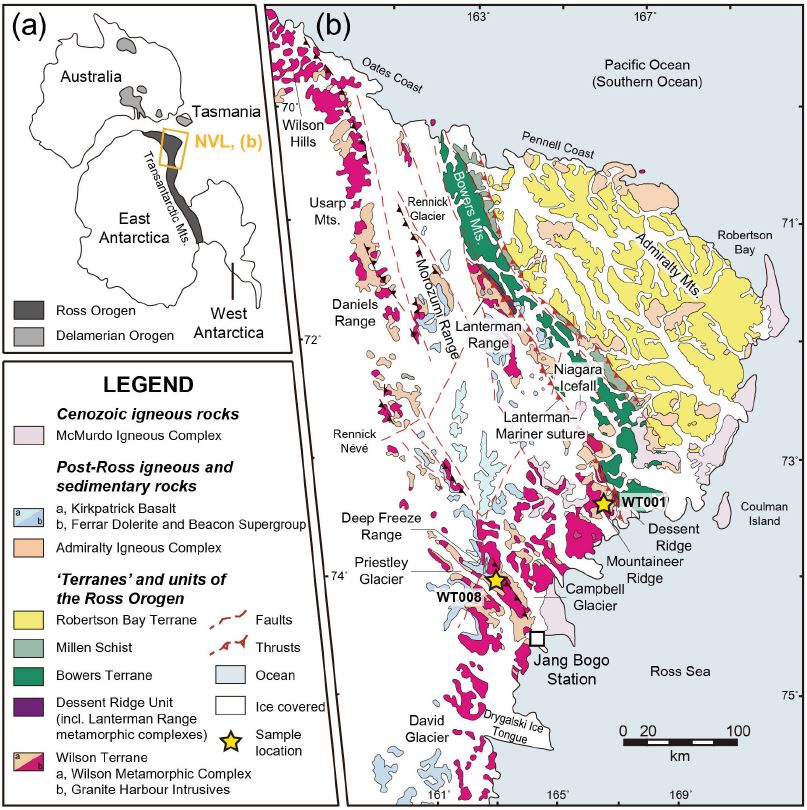
(a) Schematic map showing the contiguity of Australia and Antarctica before the breakup of Gondwana, as well as that of the Ross and Delamerian orogens. (b) Tectonic province map of northern Victoria Land (NVL), East Antarctica, with sample locations. Modified after Läufer et al. (2011). A white box indicates the location of the Jang Bogo Station.
북빅토리아랜드는 서에서 동으로 세 개의 지구조체인 윌슨(Wilson), 바우어스(Bowers), 로버트슨 베이(Robertson Bay) 암체(terrane)로 구성되어 있으며(그림 1b), 캠브리아기-오르도비스기에 이 암체들의 봉합으로 형성된 것으로 알려져 있다(Weaver et al., 1984; Kleinschmidt and Tessensohn, 1987; Roland et al., 2004; Tessensohn and Henjes-Kunst, 2005; Federico et al., 2006). 봉합 과정에 대한 지구조 모델로는 서쪽 방향으로의 안데스 형 섭입 후 주향이동운동에 의해 지금의 지형적 형태를 갖추었다는 주장과 각 암체 사이에 두 개의 서쪽 방향 섭입대에 의해 부가체 지체구조가 만들어졌다는 논쟁이 초기부터 진행되었다(Weaver et al., 1984; Bradshaw et al., 1985; Gibson and Wright, 1985; Kleinschmidt and Tessensohn, 1987). 이후 연구를 통해 지질학적, 지화학적, 지구연대학적 자료가 축적됨에 따라 수정되어 왔으나, 북빅토리아랜드 형성에 관해서 기본적으로는 후자의 모델을 따르고 있다(Roland et al., 2004; Tessensohn and Henjes-Kunst, 2005; Federico et al., 2006; Rocchi et al., 2011; Rosetti et al., 2011; Estrada et al., 2016). 북빅토리아랜드의 암체들을 구성하는 초기 고생대 퇴적물의 외래성 기원에 대한 논쟁은 이 암체들을 구분하는 초기부터 이어져 왔다(Weaver et al., 1984; Bradshaw et al., 1985; Kleinschmidt and Tessensohn, 1987). 최근 연구 결과에 따르면, 윌슨, 바우어스, 로버트슨 베이 암체에서의 쇄설성 저어콘 U-Pb 연령의 확률밀도분포는 북동쪽의 두 암체에서 오르도비스기 쇄설성 저어콘의 존재가 뚜렷한 것을 제외하면 매우 유사하다(Estrada et al., 2016; Paulsen et al., 2016). 초기 고생대 퇴적물들의 이러한 특성은 운모류의 40Ar/39Ar 연령 패턴에서도 유사하게 보고되었다(Di Vincenzo et al., 2014). 따라서, 북빅토리아랜드 윌슨, 바우어스, 로버트슨 베이 암체의 초기 고생대 퇴적물들은 유사한 기원지에서 유래하였고, 윌슨 암체로의 퇴적물 공급이 캠브리아기에 중단된 반면 바우어스, 로버트슨 베이 암체에서는 초기 오르도비스기까지 지속되었을 것으로 해석된다(Estrada et al., 2016; Paulsen et al., 2016).
로스 조산운동과 관련된 월슨 암체의 변성작용 특성 및 시기에 대한 연구는 꾸준히 진행되어 왔다(e.g., Grew and Sandiford, 1984; Talarico and Castelli, 1995; Palmeri, 1997; Henjes-Kunst et al., 2004; Schüssler et al., 2004; Goodge, 2007). 윌슨 암체의 변성작용은 바우어스 암체와의 경계에서 나타나는 랜터만(Lanterman) 산맥의 고압 변성작용과는 대조적인 저압형이 주류를 이루지만, 백립암상 변성암들이 일부 보존된 것으로 알려져 있다(Palmeri, 1997; Di Vincenzo et al., 2007, 2016). 백립암상을 비롯한 변성작용 시기 및 퇴적 상한(maximum depositional age) 제한과 기원지 추적을 위한 쇄설성 광물 연령측정은 주로 변성퇴적암으로 구성된 윌슨 암체의 지구조환경을 이해하기 위해 필수적인 요소이지만 체계적인 연구가 미진하다. 장보고 과학기지가 북빅토리아랜드 테라노바(Terra Nova) 만에 건설된 이래로 이 지역에서 국내 지질학자들도 기초 지질조사를 진행 중이다(KAGEX, 2015, 2016). 이 연구에서는 지난 남극 하계지질조사 동안 채취한 북빅토리아랜드 윌슨 암체의 두 개 편마암 시료와 이를 관입하고 있는 화성암맥 시료로부터 광물조합 및 미구조를 관찰하고, 고분해능 이차이온질량분석기를 사용하여 수선별한 저어콘 결정의 U-Pb 연령을 측정하였다. 이를 토대로 로스 조산운동과 관련된 윌슨 암체의 변성작용 시기와 특성을 소개하고 이 시료들에서 저어콘 연령이 갖는 의미에 대해 토의한다.
2. 지질학적 배경
북빅토리아랜드는 남극 대륙에서 캠브리아기-오르도비스기의 로스 조산운동 시기에 형성된 암석들이 가장 넓게 분포하는 지역이다. (그림 1b; Kleinschmidt and Tessensohn, 1987). 이들 초기 고생대 암석들은 서에서 동으로 북북서-남남동의 주향으로 배열하고 있는 윌슨, 바우어스, 로버트슨 베이 암체로 세분된다. 이들 암체의 경계는 랜터만 단층대와 립이어(Leap Year) 단층대에 의해 정의된다(그림 1b; Capponi et al., 1999; Crispini et al., 2007; Rossetti et al., 2011; Di Vincenzo et al., 2014). 윌슨 암체를 구성하는 초기 고생대 암석들은 변성퇴적암 및 혼성암과 함께 다양한 조성의 캠브리아기-오르도비스기 심성암으로 구성되어 있다(e.g., Grew and Sandiford, 1984; Talarico and Castelli, 1995; Palmeri, 1997; Bomparola et al., 2007; Giacomini et al., 2007; Rocchi et al., 2011). 바우어스 암체는 초-중기 캠브리아기의 다양한 화산암과 쇄설성 퇴적암으로 구성된 슬레저스(Sledgers) 층군과 중-후기 캠브리아의 얕은 바다에서 쌓인 이질암, 석회암, 사암 및 역암으로 구성된 메리너(Mariner) 층군, 그리고 이를 부정합으로 덮고 있는 후기 캠브리아기-초기 오르도비스기 사암-역암이 우세한 립이어 층군으로 구성되어 있다(Roland et al., 2004; Di Vincenzo et al., 2014; Estrada et al., 2016; Paulsen et al., 2016). 윌슨 암체와 바우어스 암체 사이에는 랜터만 단층대를 따라 고압의 에클로자이트, 초고철질암석 등 해양지각의 섭입과 관련된 변성암들이 산출한다(Di Vincenzo et al., 1997, 2016; Palmeri et al., 2007). 로버트슨 베이 암체는 원양성 심해 퇴적암으로 구성되어 있다(Kleinschmidt and Tessensohn, 1987).
윌슨 암체의 암상은 캠브리아기-오르도비스기 변성퇴적암과 화성암 그리고 이를 부정합으로 피복하는 후기 페름기-쥬라기 비콘(Beacon) 및 페라(Ferrar) 누층군과 신생대 맥머도(McMurdo) 화산암체로 구성되어 있다(GANOVEX, 1987). 변성퇴적암의 성분은 사질 성분이 우세하고 이질 성분의 편암과 편마암에서는 석류석 반상변정이 흔히 산출한다(e.g., Schubert, 1987; Ulitzka, 1987; Palmeri, 1997). 이와 함께 석회질 규산염암과 각섬암도 관찰된다(e.g., Schubert, 1987). 변성이질암에서 산출하는 근청석-규선석-석류석 광물조합은 저압형 변성야외구배(metamorphic field gradient)를 정의하며, 최고 변성 온도-압력 조건은 ~700-750℃, 4-5 kbar로 추정된다(Palmeri, 1997). 변성이질암의 변성도는 지역에 따라 편차를 보이며, 일부 퇴적 구조를 보존하고 있는 저변성-중변성 변성퇴적암으로 구성된 레닉(Rennick) 편암, 모로주미(Morozumi) 천매암, 리트릿 힐스(Retreat Hills) 편암 등과 고변성 편마암과 혼성암으로 구성된 윌슨 편마암, 머치슨(Murchison) 층 등이 함께 윌슨 변성복합체(Wilson Metamorphic Complex)를 구성한다(그림 1b; GANOVEX, 1987). 일부 편마암체에서는 백립암상 변성암들이 보존되어 있으며, 이들로부터 추정한 백립암상 변성작용의 온도-압력 조건은 ~700-900℃, 6-9 kbar이다(Talarico et al., 1995). 윌슨 암체의 북서부에 위치한 윌슨 힐스 지역의 혼성암 내 모나자이트와 저어콘의 U-Pb 연령으로부터 추정한 백립암상 변성작용의 시기는 ~500 Ma이다(Henjes-Kunst et al., 2004). 변성사암의 쇄설성 저어콘 U-Pb 연령은 ~0.5-0.7 Ga, ~0.9-1.3 Ga, >1.6 Ga에 분포가 집중되어 있으며, 이로부터 월슨 암체 변성퇴적암들의 모암 퇴적 상한이 ~530 Ma로 추정된 바 있다(Estrada et al., 2016; Paulsen et al., 2016). 윌슨 암체의 캠브리아기-오르도비스기 화성암인 그라니트 하버 심성암류(Granite Harbour Intrusives)는 몬조화강암, 화강섬록암, 토날라이트 등으로 암상이 다양하다(Borg et al., 1987; Ghezzo et al., 1987; Armienti et al., 1990; Rocchi et al., 1998, 2004). 이들을 분석한 지화학 자료는 화산호 환경에서의 캘크-알칼라인(calc-alkaline) 계열의 마그마 형성을 지시하지만, K 함량의 변화가 크고 I-형 저알루미늄(metaluminous) 및 S-형 과알루미늄(peraluminous)의 지화학적 특성을 갖는 심성암이 모두 산출한다(Borg et al., 1987; Vetter and Tessensohn, 1987; Armienti et al., 1990; Biagini et al., 1991a, 1991b; Di Vincenzo and Rocchi, 1999; Dallai et al., 2003; Rocchi et al., 2004, 2011). 심성암의 관입이 변성퇴적암 엽리의 형성보다 선행, 동시, 후행하는 구조가 모두 나타나며, 이들의 정치 연령은 480-530 Ma이다(Armienti et al., 1990; Tonarini and Rocchi, 1994; Fioretti et al., 2005; Bomparpla et al., 2007; Giacomini et al., 2007).
3. 암석 기재
저어콘 U-Pb 연령 측정을 위해 윌슨 암체에서 두 개의 호상 편마암과 이를 관입하고 있는 우백질 암맥 시료를 채취하였다. 첫 번째 편마암 시료는 마운트니어(Mountaineer) 변성암 복합체 내 머치슨층에서 채취하였다(그림 1b). 이 시료(WT001A)는 우흑대와 우백대의 구분이 뚜렷한 단사휘석-흑운모 편마암으로(그림 2a, 2b), 변형된 석영맥과 페그마타이트 암맥이 함께 산출한다(그림 2b). 호상 편마암의 엽리를 자르며 관입한 우백질 암맥과(WT001B)과 이를 다시 자르며 관입한 고철질 암맥을 관찰할 수 있다(그림 2a). 호상 편마암 내부에는 습곡을 이루고 있는 우백질 암맥이 관찰되는데 이는 호상 편마암의 엽리를 자르고 있는 우백질 암맥(WT001B)보다 이른 시기에 관입한 것으로 해석된다(그림 2a). 호상 편마암(WT001A)의 대표광물조합은 단사휘석-흑운모-정장석-석영-사장석으로(그림 3a), 소량의 백운모, 티타나이트와 함께 저어콘과 인회석이 부구성광물로 산출한다. 흑운모, 석영과 사장석이 각각 농집된 우흑대와 우백대가 교호하며 성분적층(compositional layering)을 잘 정의한다. 단사휘석은 대개 500 μm 이하인 반자형 내지 타형으로, 흑운모로 치환되는 조직을 제외하고는 다른 주구성광물들과의 경계부가 뚜렷하여 조직적 평형관계에 있고(그림 3a), 상대적으로 흑운모가 결핍된 우백질은 부딘(boudin)화된 렌즈 형태로 엽리에 조화롭게 산출한다. 석영은 단결정과 파동소광이 우세하며, 주변부에서 재결정작용에 의해 입자 경계가 불규칙한 아입자(subgrain)가 관찰된다(그림 3b). 사장석은 흔히 끝이 점점 가늘어지는 취편쌍정(polysynthetic twin)이 특징적이며, 흑운모-석영 포획물을 함유한 반상변정으로도 산출한다(그림 3b). 호상 편마암을 관입하고 있는 우백질 암맥(WT001B)의 대표광물조합은 티타나이트-각섬석-단사휘석-사장석-석영이다(그림 3c). 사장석이 풍부한 우백질 영역과 단사휘석 및 각섬석이 풍부한 우흑질 영역이 약한 엽리를 정의한다. 휘석 및 각섬석은 중립질의 반자형 내지 타형(1-3 mm), 사장석은 대부분 조립질의 자형 내지 반자형 결정(장경 3-10 mm)으로 산출한다. 고철질 광물들 및 사장석은 흑운모-녹니석 및 견운모로의 변질이 심하다(그림 3c).
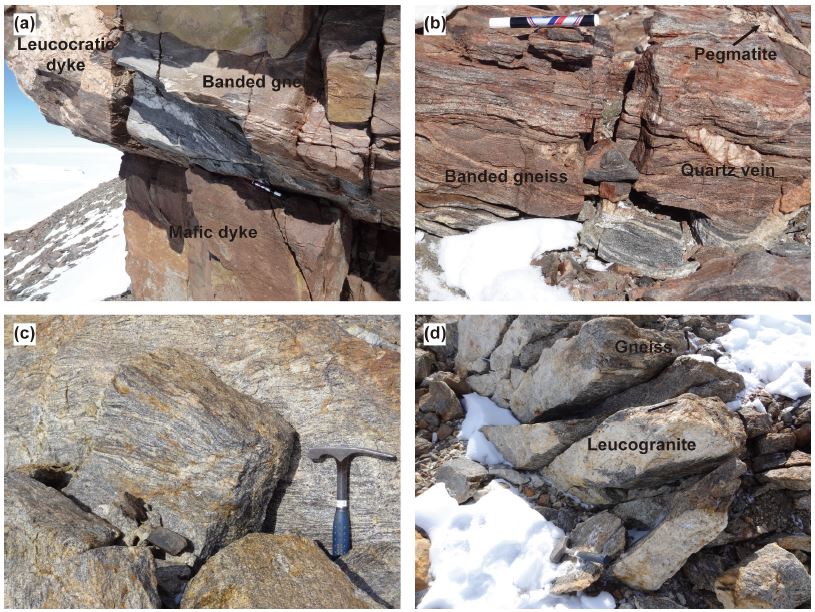
Outcrop photographs showing relative chronology between host gneisses and intruding dykes of variable compositions from the Mt. Murchison (a, b) and Deep Freeze Range (c, d), respectively. (a) Banded gneiss (sample WT001A) was cross-cut by leucocratic dyke (sample WT001B), and both lithologies were intruded by mafic dyke. (b) Banded gneiss with sub-concordant quartz vein and pegmatite patch. (c) Banded gneiss (sample WT008) with penetrative gneissic foliation defined by leuco- and melano-cratic layers. (d) Leucogranite containing garnet and cordierite (dark and greenish spots) discordantly emplaced into banded gneiss.
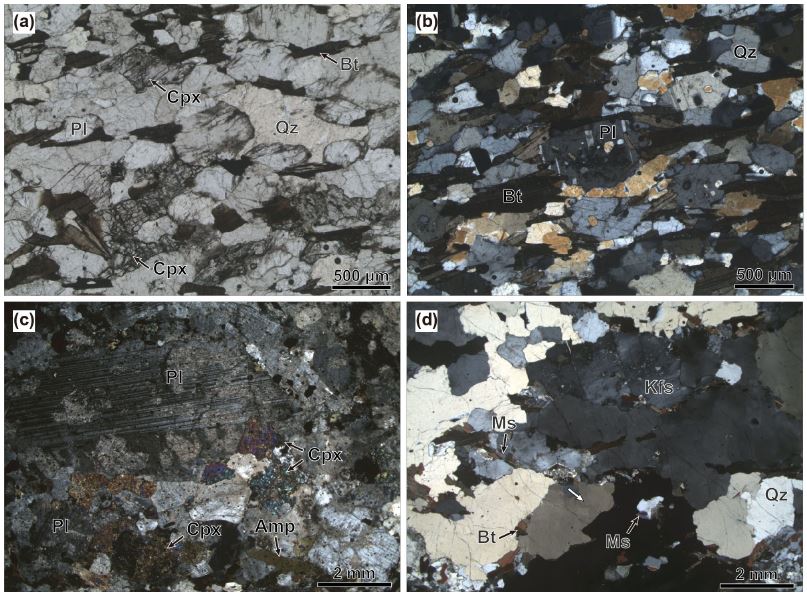
Photomicrographs of banded gneisses and intruding leucocratic dyke showing representative mineral assemblages and microstructures. (a, b) Clinopyroxene-biotite banded gneiss (sample WT001A) showing clinopyroxene- rich (a) and -poor domains (b), respectively. Clinopyroxene is in textural equilibrium with other rock-forming minerals in (a). Inclusion-rich plagioclase porphyroblasts are rarely observed in (b). (c) Highly altered leucocratic dyke (sample WT001B) showing euhedral plagioclase, sub- to an-hedral clinopyroxene and amphibole, and sericite. (d) Biotite banded gneiss (sample WT008) showing chessboard extinction of quartz (white arrow), exsolution texture in K-feldspar, and fine-grained muscovite. Amp-amphibole; Bt-biotite; Cpx-clinopyroxene; Kfs-K-feldspar; Ms-muscovite; Pl-plagioclase; Qz-quartz.
두 번째 편마암 시료는 딥 프리즈 레인지(Deep Freeze Range)의 프리스틀리(Priestley) 편암 지역에서 채취하였다(그림 1b). 이 시료(WT008)는 흑운모 편마암으로, 앞서 서술한 편마암 시료와 유사하게 우백질과 우흑질로 분리된 뚜렷한 엽리를 보이며 우백질 화강암에 의해 관입된 구조를 나타낸다(그림 2c, 2d). 흑운모 편마암의 대표광물조합은 흑운모-정장석-사장석-석영으로, 소량의 티타나이트와 백운모 및 부구성광물인 저어콘과 인회석을 포함한다. 흔히 얇은 조각(flake; 장경 <1 mm) 혹은 집합체 형태로 산출하는 흑운모와 단결정이 우세한 조립질의 석영(~5 mm)이 약하게 발달한 엽리를 정의한다(그림 3d). 석영보다는 입자가 작은 자형 내지 반자형의 사장석 및 정장석 또한 다양한 정도로 엽리에 배열한다. 석영은 파동소광과 고온(~650℃이상)에서의 변형을 지시하는 체스보드 소광(chessboard extinction)이 특징적인 반면(Kruhl, 1996), 사장석과 정장석에서는 연성변형작용에 의한 미구조가 특별히 관찰되지 않는다(그림 3d). 주구성광물들의 입자 경계는 곡선형이 우세하다. 티타나이트와 백운모는 두께가 500 μm 이하인 얇은 풀 혹은 띠 형태의 흑운모-K-장석-사장석-석영±티타나이트±백운모 교대성장으로만 산출한다. 이 다광물 집합체 역시 대체로 엽리에 배열하고 석영-장석 입자들의 간극을 충진하는데, 이러한 조직은 K 및 Al (±Ti)이 농집된 용융물이 결정화하였음을 지시한다. 이차광물로는 녹니석이 산출한다.
4. 분석 방법
채취한 암석 시료들을 유압파쇄기와 진동컵분쇄기를 이용하여 분말로 만들었다. 체를 사용하여 이 분말에서 230 ㎛ 이하의 광물결정들을 분리한 후 물과 중액을 이용한 전통적인 비중분리법과 자성분리법을 적용한 후 마지막으로 수작업을 거쳐 저어콘 결정들을 추출하였다(Cheong et al., 2013). 분리된 저어콘 결정들을 표준시료와 함께 에폭시마운트에 시료별로 고정시킨 후, 저어콘 입자가 절반정도 드러날 때까지 연마하였다. U 농도를 측정하기 위하여 SL13 저어콘 표준시료를 사용하였고(238 ppm U; Claoué-Long et al., 1995), U-Pb 동위원소 조성은 미국 미네소타주에 산출하는 둘루스 복합체(Duluth Complex)의 FC1 저어콘 표준시료를 사용하여 검정선을 수립하였다(206Pb*/238U=0.1859; Paces and Miller, 1993). 연마된 저어콘 결정들의 내부 조직 관찰을 위한 후방산란전자영상 및 음극선발광영상은 한국기초과학지원연구원 오창 캠퍼스에 설치된 주사전자현미경(SEM; JEOL-6610LV)을 이용하여 촬영하였다.
저어콘의 U-Pb 성분은 한국기초과학지원연구원 오창 캠퍼스에 설치되어 있는 고분해능 이차이온질량분석기(SHRIMP-IIe) 장비를 이용하여 분석하였다. 동위원소 분석을 위하여 O2- 일차이온 빔을 사용하였으며, 빔의 크기와 전류는 각각 ~20 ㎛ 및 ~3 nA였다. 산화체 혹은 수화체 형태의 분자 이온들에 의한 질량 간섭을 제거하기 위해 ~5,000의 질량 분해능을 이용하였다. 연령측정을 위한 검정선 수립은 Williams (1998)에 제시된 방법에 따라 수행하였고, 분석한 저어콘의 U-Th-Pb 동위원소비는 PRAWN/LEAD 6.5.5 프로그램(T.R. Ireland, written communication, 1996)을 사용하여 계산하였다. 이후 등시성연령, 가중평균연령, 확률밀도분포도 작성에는 Isoplot/EX 프로그램(Ludwig, 2003)을 이용하였다. 보통납의 보정은 보통납 모델 성분을 이용하여 실시하였으며(Cumming and Richards, 1975), 1,200 Ma 보다 오래된 저어콘에 대해서는 204Pb 보정법을, 그리고 이보다 젊은 저어콘은 207Pb 보정법을 적용하였다(Williams, 1998). 불확실도(uncertainty) 계산에는 계측통계학적(counting statistics) 오차, 배경값에 기인한 오차와 함께 표준시료의 검정선 수립에서 발생한 오차(±0.5%)를 반영하였다. 이로부터 구한 연령의 불확실도는 95% 신뢰수준(tσ)으로 계산하였다.
일부 시료의 저어콘 중 보통납의 함량이 전체 납에서 1%가 넘는 경우는 이후 연령계산에서 제외하였다(표 1). 일부 분석치는 서로 다른 연령의 방사성 기원 납들이 혼합되었거나, 납 손실에 의해 207Pb/206Pb과 206Pb/238U 연령의 불일치도가 높다. 따라서, 불일치도가 10% 이상인 경우에도 이후 계산에서 제외하였다. 일부 시료의 U 함량이 높은 저어콘 결정들(>2,500 ppm)은 표준시료와의 U 농도 차이에서 생기는 기질효과(matrix effect)가 발생할 뿐만 아니라(Kikuchi and Hidaka, 2009) 납 손실의 가능성도 크기 때문에 연령의 지질학적 의미를 이해하기 어려워 역시 연령계산에서 제외하였다.
5. 결 과
5.1 저어콘의 결정 형태와 누대 구조
머치슨 층의 호상 편마암 시료(WT001A)에서 산출하는 저어콘 결정들은 대부분 자형-반자형의 결정형을 나타내지만, 원마도와 내부 구조가 다양하다(그림 4a). 일부 저어콘 결정들은 진동누대 구조(e.g., 결정번호 2, 4, 40) 혹은 핵-가장자리(core-rim) 누대구조를 나타내는 결정도 있는 반면(e.g., 결정번호 33), 뚜렷한 누대구조가 나타나지 않는 결정도 관찰된다(e.g., 결정번호 16, 18, 22). 또한 일부 결정들에서 가장자리에 매우 어두운 음극선발광의 얇은 과성장 띠가 관찰된다(e.g., 결정번호 27, 29, 33). 이 과성장 띠는 변성 기원일 가능성이 있지만 고분해능 이차이온질량분석기의 공간 분해능에 비해 폭이 좁다. 우백질 암맥 시료(WT001B)에서 산출하는 저어콘 결정들은 대부분 자형이며, 장단축비(aspect ratio)는 2:1-3:1 범위이다(그림 4b). 저어콘 결정의 내부 구조는 상속핵과 가장자리의 진동누대 구조로 대표된다(e.g., 결정번호 14, 15, 26). 일부 결정에서는 상속핵과 진동누대 구조를 갖는 가장자리(회색의 음극선발광) 사이에 어두운 음극선발광으로 구분되는 내부 조직이 나타나고(e.g., 결정번호 2, 5, 13, 15, 18, 23, 28), 가장자리 진동누대 구조가 결여되어 있는 결정도 관찰된다(e.g., 결정번호 1, 8, 20). 프리스틀리 편암 지역에서 채취한 흑운모 호상 편마암 시료(WT008)에서 산출하는 저어콘 결정들은 머치슨 층의 단사휘석-흑운모 호상 편마암 시료(WT001A)의 저어콘 결정들과 유사한 내부 구조와 원마도를 가지며 반자형-타형의 결정형을 보인다(그림 4c).
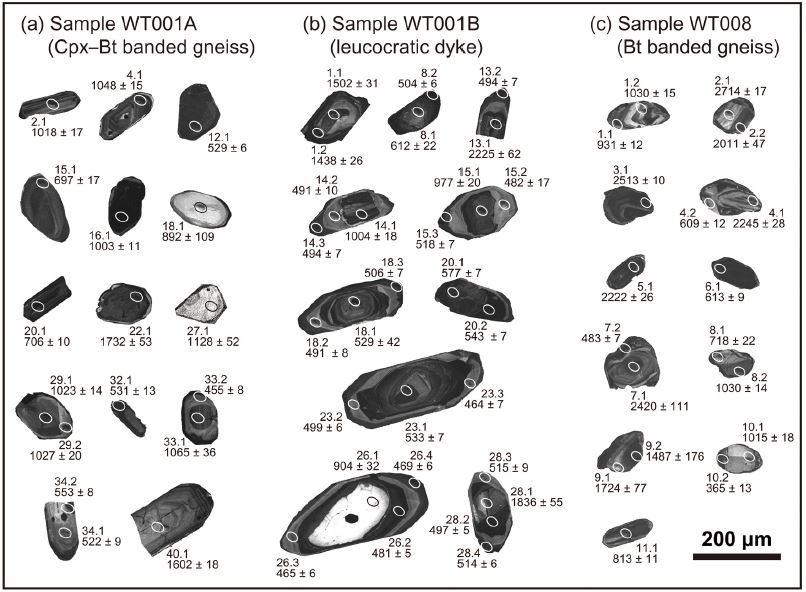
Cathodoluminescence images of zircon from (a) clinopyroxene-biotite banded gneiss (sample WT001A), (b) leucocratic dyke (sample WT001B), and (c) biotite banded gneiss (sample WT008). The grain numbers used in Table 1 are shown in each image of zircon. Ellipses denote the SHRIMP analytical spots, and numbers represent the 206Pb/238U or 207Pb/206Pb ages of the spots.
5.2 저어콘의 U-Pb 연령
세 개 시료의 79개 저어콘 결정에서 총 122개 점 분석을 실시하였으며, 이 중 상당수의 점 분석에서 10% 이상의 불일치도가 나타났다(표 1). 머치슨 층 단사휘석-흑운모 호상 편마암 시료(WT001A)의 저어콘 결정에서 총 47개의 점 분석을 실시하였으며, 이를 일치곡선 상에 도시하였다(그림 5a). 4개의 점 분석은 U 함량이 2,500 ppm 이상이거나 보통납의 함량이 1% 이상이다(표 1; 그림 5a). 90% 이상의 일치도를 나타내는 28개의 점 분석은 1.0-1.2 Ga와 530-700 Ma 범위에 집중되고, 한 개 점 분석의 겉보기연령이 ~1.8 Ga이다(그림 5a). 이에 반해 1.2-1.6 Ga와 700-900 Ma 범위에는 점 분석이 전무하다(그림 5a). 530-700 Ma에 해당하는 점 분석들은 산개형으로 분포하며, 넓은 범위의 Th/U 비(0.02-0.98)를 갖는다(표 1). 이 시료를 관입하고 있는 우백질 암맥 시료(WT001B)에서 채취한 저어콘 결정에서 총 57개의 점 분석을 실시한 결과, U과 보통납의 함량이 각각 2,500 ppm과 1% 이상인 4개의 점 분석을 제외하면(표 1; 그림 5b) 일치도가 90% 이상인 점 분석 연령은 470-520 Ma 범위에 집중된다. 저어콘 결정 상속핵의 점 분석 연령 분포는 호상 편마암 시료(WT001A)의 저어콘 연령 분포와 유사하다. 저어콘 결정의 가장자리에서 측정한 점 분석들은 Th/U 비가 상대적으로 낮고(<0.1), 500 Ma보다 젊은 후기 캠브리아기-초기 오르도비스기 U-Pb 연령을 나타낸다(표 1; 그림 4b, 5b). 진동누대 구조가 특징적인 가장자리에서 측정한 U-Pb 성분 중 90% 이상의 일치도를 보이는 점 분석들에서 계산한 가중평균연령은 482±4 Ma (tσ)이다(그림 6). 프리스틀리 편암 지역에서 채취한 흑운모 호상 편마암 시료(WT008)의 11개 저어콘 결정에서 총 18개의 점 분석을 실시하였으며, 분석한 저어콘의 동위원소 성분은 납 손실과 이종 방사성 기원 납의 혼합에 의해 불일치도가 높다(표 1; 그림 5c). 하지만 일부 일치도가 높은 점 분석 연령들은 머치슨 층 호상 편마암 시료(WT001A)의 저어콘에서와 유사한 U-Pb 연령 분포 형태를 나타낸다(그림 5a, 5c).
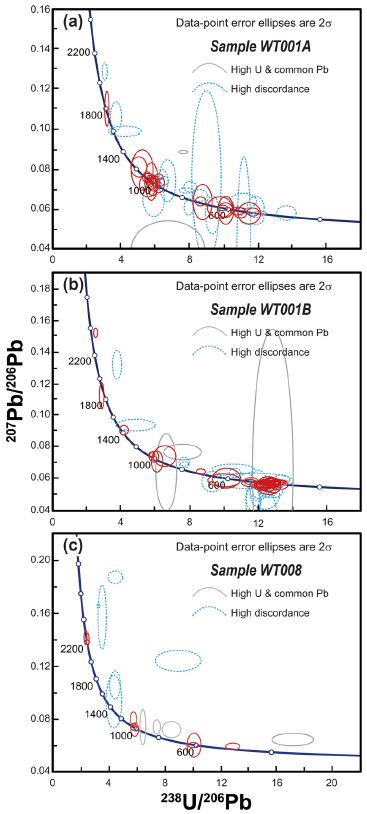
The Tera-Wasserburg concordia diagrams showing the spot analyses of zircon from (a) clinopyroxene-biotite banded gneiss (sample WT001A), (b) leucocratic dyke (sample WT001B), and (c) biotite banded gneiss (sample WT008). Grey and blue ellipses denote spot analyses with high contents of U and common Pb, and >10% discordance, respectively. Thus, only spot analyses denoted as red ellipses are considered for age calculation.
6. 토 의
북빅토리아랜드 윌슨 암체를 구성하는 퇴적암들의 기원지 정보와 변성작용 시기에 대한 연구는 제한적으로 이루어졌다. 최근 수행된 연구는 윌슨 암체의 남에서 북으로 프리스틀리 편암, 윌슨 편마암, 랜터만 편암-편마암, 모로주미 천매암, 레닉 편암, 버그 층군(Berg Group) 등의 암석들에서 로스-판아프리카(Pan-African)-그렌빌(Grenville) 조산운동 시기 저어콘 연령이 우세하고 남극 대륙 기반암을 지시하는 중원생대 이상의 연령이 산재하는 등 모두 유사한 쇄설성 저어콘 연령 분포 특징을 확인한 바 있다(그림 7b; Adams et al., 2014; Estrada et al., 2016; Paulsen et al., 2016). 또한 주로 변성사암들에서 가장 젊은 저어콘 연령인 ~530 Ma가 퇴적 상한으로 추정되었다. Henjes-Kunst et al. (2004)은 윌슨 힐스(Wilson Hills)에 산출하는 상부각섬암상-백립암상의 혼성암 내 저어콘 U-Pb 연령측정을 통해 메타텍사이트(metatexite)에서는 206Pb/238U 가중평균연령이 500±4 Ma (2σ)와 484±5 Ma (2σ)의 쌍모식(bimodal) 일치연령을, 다이아텍사이트(diatexite)와 혼성암질 편마암에서는 메타텍사이트 저어콘의 젊은 일치연령과 불확실도 내에서 동일한 각각 475±4 Ma, 488±6 Ma를 도출하였다. 이는 지구조운동 후 화강암맥의 정치연령인 482±4 Ma와도 유사하다(Henjes-Kunst et al., 2004). 저어콘과는 달리 동일한 메타텍사이트와 다이아텍사이트 시료에서 측정한 모나자이트의 206Pb/238U 가중평균연령은 499±10 Ma (2σ)과 493±9 Ma (2σ)로 저어콘 보다 오래된 연령이 도출되었다. 이들 결과를 종합하여 백립암상의 변성작용 시기를 ~500 Ma로 제안하고, 이후 ~490-470 Ma 시기를 감압 또는 냉각에 따른 후퇴변성 작용의 시기로 해석한 바 있다(Henjes-Kunst et al., 2004; Schüssler et al., 2004). ~500 Ma의 변성 연령은 지구조운동 전, 중, 후 화성암의 관입 연령으로부터 추정된 바도 있다(Rocchi et al., 2011).
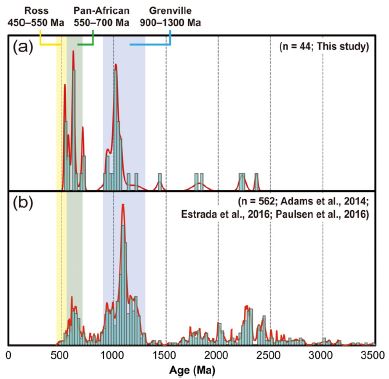
Probability density diagrams showing the U-Pb age distributions of detrital zircon from (a) two banded gneisses and a leucocratic dyke (this study) and (b) the Priestley Schist compiled from available literatures (Adams et al., 2014; Estrada et al., 2016; Paulsen et al., 2016). Temporal ranges of the relevant geologic activities such as the Ross (yellow), Pan-African (green), and Grenville orogenies (blue) are also shown.
머치슨 층과 딥 프리즈 레인지에서 채취한 호상 편마암 시료 WT001A와 WT008에서 분석한 저어콘의 점 분석 연령은 ~1.0-1.2 Ga와 ~530-700 Ma 사이에 집중되고, 1.6 Ga 이상에서 산재한 반면, 700-900 Ma와 1.2-1.6 Ga 사이에는 결여된 분포 특징을 보인다(그림 5a, 5c). 이러한 연령 분포 형태는 우백질 암맥 시료(WT001B)의 저어콘 상속핵의 연령 분포에서도 동일하게 확인된다(그림 5b). 호상 편마암 시료의 저어콘과 우백질 암맥의 저어콘 상속핵 U-Pb 연령 분포를 통계적으로 이해하기 위하여 확률밀도분포도를 작성한 결과(그림 7a), 저어콘 연령들은 ~530 Ma, ~600 Ma, ~1.0 Ga의 첨두를 가지며, 이들 연령은 각각 로스, 판아프리카, 그렌빌 조산운동 시기를 대표함을 알 수 있다(그림 7a). 그 외 남극 기반암으로부터의 퇴적물 유입을 지시하는 더 오래된 선캠브리아기 연령들(>1.6 Ga)이 산재한다. 확률밀도분포도 상에서 나타나는 또 다른 큰 특징으로는 판아프리카-그렌빌 연령 사이와 그렌빌-대륙 기반암 연령 사이에 연령 밀도가 현저히 낮아지는 영역이 존재한다는 점이다. 이러한 연령 결핍은 최근 보고된 윌슨 암체 변성사암들의 쇄설성 저어콘 U-Pb 연령 분포와 유사하다(그림 7b; Adams et al., 2014; Estrada et al., 2016; Paulsen et al., 2016). 호상 편마암 시료의 저어콘 점 분석 중 가장 젊은 206Pb/238U 연령은 529±6 Ma (1σ)이며, Th/U 비는 0.77이다(표 1). 이 연령은 기존 연구에서 변성사암의 쇄설성 저어콘으로부터 추정한 퇴적 상한(~530 Ma)과 불확실도 내에서 일치한다(Estrada et al., 2016; Paulsen et al., 2016). 초기 캠브리아기 저어콘의 상대적으로 낮은 산출 빈도, 높은 Th/U 비, 변성작용을 지시하는 내부 구조의 부재는 호상 편마암 시료들의 가장 젊은 점 분석 연령이 쇄설성 기원임을 뒷받침하고, 저어콘 결정들에서 관찰되는 다양한 누대구조와 원마도의 차이는 복수의 기원지에서 쇄설성 저어콘 결정들이 공급되었을 가능성을 시사한다(Fedo et al., 2003). 이러한 저어콘 U-Pb 연령 측정의 결과로부터 호상 편마암 시료 WT001A와 WT008의 광물조합인 단사휘석-흑운모-정장석-석영-사장석과 흑운모-정장석-사장석-석영의 안정영역에서 변성 저어콘의 과성장이 미약하거나 거의 일어나지 않은 것으로 추정된다(e.g., Williams, 2001).
호상 편마암 시료(WT001A)를 관입하고 있는 우백질 암맥 시료(WT001B)에서 분석한 저어콘의 점 분석 중 상속핵의 U-Pb 연령 분포가 호상 편마암 시료 WT001A와 WT008의 저어콘 U-Pb 연령 분포와 유사한 점을 미루어 보아, 이 관입 암맥의 기원이 호상 편마암과 같은 변성퇴적암의 재용융 작용에 의한 것임을 추정할 수 있다(그림 5). 이 암맥 시료의 저어콘 결정은 대부분 자형이고, 가장자리에 진동누대 구조를 가지는 과성장 띠가 존재한다(그림 4b). 이 과성장 띠에서 측정한 점 분석들의 Th/U 비는 0.1 보다 낮으며, 일치도가 90% 이상인 점 분석들의 가중평균연령은 482±4 Ma (tσ)이다(그림 6). 이로부터 우백질 암맥의 관입 시기가 ~480 Ma임과 함께 호상 편마암의 변성작용 시기가 퇴적 상한과 관입 연령의 사이인 480-530 Ma 사이임을 알 수 있다. 호상 편마암의 저어콘 결정으로부터 변성시기를 제한할 수 있는 직접적인 증거를 찾을 수 없지만, 우백질 암맥의 저어콘으로부터 간접적인 증거를 찾을 수 있다. 우백질 암맥의 일부 저어콘 결정에서 상속핵과 가장자리 진동누대 구조 사이에 어두운 음극선발광영상의 내부 영역과 진동누대 구조가 결여되어 있는 결정을 관찰할 수 있다(그림 4b). 이 영역에 대한 점 분석 206Pb/238U 연령은 500±7 Ma (1σ), 504±6 Ma (1σ), 499±6 Ma (1σ), 497±6 Ma (1σ)이고, Th/U 비는 ~0.03으로 낮다(표 1; 그림 4b). 이러한 내부 조직과 Th/U 비는 저어콘 결정의 이 영역이 재결정작용 중 성장하였을 가능성을 제시한다(Hoskin and Schaltegger, 2003). 호상 편마암과 이를 관입하고 있는 화성 암맥에서의 저어콘 U-Pb 연령 측정 결과를 종합하면 윌슨 암체를 구성하는 고생대 퇴적물의 공급은 적어도 초기 캠브리아기까지 이어졌으며, 퇴적물들이 경험한 백립암상의 광역변성 작용은 ~500 Ma에 일어났고, 이들 변성퇴적암들의 재용융은 ~480 Ma에 일어난 것으로 해석할 수 있다.
Kelsey et al. (2008)은 저어콘과 모나자이트의 포화도 실험 자료와 이질암과 사암 성분을 이용하여 규장질 마그마에서 저어콘과 모나자이트의 성장에 관한 열역학 모델링을 실시하였고, 용융체에서 저어콘의 성장이 모나자이트에 비해 앞서는 결과를 도출하였다(Kelsey et al., 2008). Henjes-Kunst et al. (2004)가 보고한 윌슨 힐스에서 산출하는 혼성암, 특히 다이아텍사이트에서 성장한 모나자이트의 연령은 저어콘에 비해 ~20 Ma 오래된 결과를 보여주고 있어, Kelsey et al. (2008)의 모델링 결과를 고려하면 윌슨 힐스 혼성암의 모나자이트 206Pb/238U 연령(~500 Ma)과 저어콘 206Pb/238U 연령(~490-470 Ma)을 각각 백립암상의 변성작용 시기와 이후 후퇴변성 작용의 시기로 특정하기에는 어려움이 있다. 이번 연구에서 관찰된 저어콘의 내부 구조와 ~500 Ma의 206Pb/238U 점 분석 연령은 백립암상의 변성작용 시기로 해석한 기존 연구결과와 잘 일치하며(표 1; 그림 4b), 이와 함께 ~480 Ma의 새로운 열적 유입에 의한 용융작용이 있었음을 제시한다(그림 4b, 6).
7. 결 론
남극 북빅토리아랜드 윌슨 암체에서 산출하는 호상 편마암과 이를 관입하고 있는 우백질 암맥의 저어콘 U-Pb 연령 측정 결과, 윌슨 암체로의 퇴적물의 공급이 적어도 초기 캠브리아기까지 이어졌으며, 이후 백립암상의 광역 변성작용이 ~500 Ma에 일어났음을 지시한다. 또한 우백질 암맥의 저어콘 상속핵과 호상 편마암 저어콘들의 연령 분포의 유사성에 미루어 보아 ~480 Ma에 또 다른 열적 공급에 의해 변성퇴적암의 재용융이 일어났음을 알 수 있다.
Acknowledgments
이 논문은 2017년 해양수산부 재원으로 한국해양과학기술진흥원의 지원을 받아 수행된 연구임(남극 빅토리아랜드 지역 지각진화 및 행성형성과정 연구(PM17030)). 건설적인 심사평를 주신 익명의 두 분 심사자께 감사드립니다.
References
-
Adams, C.J., Bradshaw, J.D., and Ireland, T.R., (2014), Provenance connections between late Neoproterozoic and early Palaeozoic sedimentary basins of the Ross Sea region, Antarctica, south-east Australia and southern Zealandia, Antarctic Science, 26, p173-182.
[https://doi.org/10.1017/s0954102013000461]

-
Armienti, P., Ghezzo, C., Innocenti, F., Manetti, P., Rocchi, S., and Tonarini, S., (1990), Isotope geochemistry and petrology of granitoid suites from Granite Harbour intrusives of the Wilson Terrane, North Victoria Land, Antarctica, European Journal of Mineralogy, 2, p103-123.
[https://doi.org/10.1127/ejm/2/1/0103]

- Biagini, R., Di Vincenzo, G., and Ghezzo, C., (1991a), Petrology and geochemistry of peraluminous granitoids from Priestley and Aviator glacier region, Northern Victoria Land, Antarctica, Memorie della Societa Geologica Italiana, 46, p205-230.
- Biagini, R., Di Vincenzo, G., and Ghezzo, C., (1991b), Mineral chemistry of metaluminous granitoids between the David and Campbell glaciers, Victoria Land, Antarctica, Memorie della Societa Geologica Italiana, 46, p231-247.
-
Boger, S.D., and Miller, J.McL., (2004), Terminal suturing of Gondwana and the onset of the Ross-Delamerian Orogeny: the cause and effect of an Early Cambrian reconfiguration of plate motions, Earth and Planetary Science Letters, 219, p35-48.
[https://doi.org/10.1016/s0012-821x(03)00692-7]

-
Bomparola, R.M., Ghezzo, C., Belousova, E., Griffin, W.L., and O’Reilly, S.Y., (2007), Resetting of the U-Pb zircon system in Cambro-Ordovician intrusives of the Deep Freeze Range, northern Victoria Land, Antarctica, Journal of Petrology, 48, p327-364.
[https://doi.org/10.1093/petrology/egl064]

-
Borg, S.G., Stump, E., Chappell, B.W., McCulloch, M.T., Wyborn, D., Armstrong, R.L., and Holloway, J.R., (1987), Granitoids of northern Victoria Land, Antarctica; implications of chemical and isotopic variations to regional crustal structure and tectonics, AmericanJournal of Science, 287, p127-169.
[https://doi.org/10.2475/ajs.287.2.127]

- Bradshaw, J.D., Weaver, S.D., and Laird, M.G., (1985), Suspect terranes in northern Victoria Land, Antarctica, In: Craddock, C. (eds.), Antarctic Geoscience, University of Wisconsin Press, Madison, p36-39.
-
Capponi, G., Crispini, L., and Meccheri, M., (1999), Structural history and tectonic evolution of the boundary between the Wilson and Bowers terranes, Lanterman Range, northern Victoria Land, Antarctica, Tectonophysics, 312, p249-266.
[https://doi.org/10.1016/s0040-1951(99)00174-2]

-
Cawood, P.A., (2005), Terra Australis Orogen: Rodinia breakup and development of the Pacific and Iapetus margins of Gondwana during the Neoproterozoic and Paleozoic, Earth-Science Reviews, 69, p249-279.
[https://doi.org/10.1016/j.earscirev.2004.09.001]

-
Cheong, W., Cho, M., and Kim, Y., (2013), An efficient method for zircon separation using the gold pan, Journal of the Petrological Society of Korea, 22, p63-70, (in Korean with English abstract).
[https://doi.org/10.7854/jpsk.2013.22.1.063]

- Claoué-Long, J.C., Compston, W., Roberts, J., and Fanning, C.M., (1995), Two Carboniferous ages: a comparison of SHRIMP zircon dating with conventional zircon ages and 40Ar/39Ar analysis, In: Berggren, W.A., Kent, D.B., Auberey, M.P., and Hardenbol, J. (eds.), Geochronology, Time Scales, and Global Stratigraphic Correlation, SEPM (Society for Sedimentary Geology) Special Publication, 4, p3-21.
-
Crispini, L., Di Vincenzo, G., and Palmeri, R., (2007), Petrology and 40Ar-39Ar dating of shear zones in the Lanterman Range (northern Victoria Land, Antarctica): implications for metamorphic and temporal evolution at terrane boundaries, Mineralogy and Petrology, 89, p217-249.
[https://doi.org/10.1007/s00710-006-0164-2]

-
Cumming, G.L., and Richards, J.R., (1975), Ore lead isotope ratios in a continuously changing earth, Earth and Planetary Science Letters, 28, p155-171.
[https://doi.org/10.1016/0012-821x(75)90223-x]

-
Dallai, L., Ghezzo, C., and Sharp, Z.D., (2003), Oxygen isotope evidence for crustal assimilation and magma mixing in the Granite Harbour Intrusives, NorthernVictoria Land, Antarctica, Lithos, 67, p135-151.
[https://doi.org/10.1016/s0024-4937(02)00267-0]

-
Di Vincenzo, G., Carosi, R., Palmeri, R., and Tiepolo, M., (2007), A comparative U-Th-Pb (zircon-monazite) and 40Ar-39Ar (muscovite-biotite) study of shear zones in northern Victoria Land (Antarctica): implications for geochronology and localized reworking of the Ross Orogen, Journal of Metamorphic Geology, 25, p605-630.
[https://doi.org/10.1111/j.1525-1314.2007.00717.x]

-
Di Vincenzo, G., Grande, A., and Rossetti, F., (2014), Paleozoic siliciclastic rocks from northern Victoria Land (Antarctica): Provenance, timing of deformation, and implications for the Antarctica-Australia connection, Geological Society of America Bulletin, 126, p1416-1438.
[https://doi.org/10.1130/b31034.1]

- Di Vincenzo, G., Horton, F., and Palmeri, R., (2016), Protracted (~30 Ma) eclogite-facies metamorphism in northern Victoria Land (Antarctica): Implications for the geodynamics of the Ross/Delamerian Orogen, Gondwana Research, 40, p91-106.
-
Di Vincenzo, G., Palmeri, R., Talarico, F., Andriessen, P.A.M., and Ricci, C.A., (1997), Petrology and geochronology of eclogites from the Lanterman Range, Antarctica, Journal of Petrology, 38, p1391-1417.
[https://doi.org/10.1093/petroj/38.10.1391]

-
Di Vincenzo, G., and Rocchi, S., (1999), Origin and interaction of mafic and felsic magmas in an evolving late orogenic setting: the early Paleozoic Terra Nova Intrusive Complex, Antarctica, Contributions to Mineralogy and Petrology, 137, p15-35.
[https://doi.org/10.1007/s004100050579]

-
Estrada, S., Läufer, A., Eckelmann, K., Hofmann, M., Gätner, A., and Linnemann, U., (2016), Continuous Neoproterozoic to Ordovician sedimentation at the East Gondwana margin - Implications from detrital zircons of the Ross Orogen in northern Victoria Land, Antarctica, Gondwana Research, 37, p426-448.
[https://doi.org/10.1016/j.gr.2015.10.006]

-
Federico, L., Capponi, G., and Crispini, L., (2006), The Ross orogeny of the transantarctic mountains: a northern Victoria Land perspective, International Journal of Earth Sciences, 95, p759-770.
[https://doi.org/10.1007/s00531-005-0063-5]

-
Fedo, C.M., Sircombe, K.N., and Rainbird, R.H., (2003), Detrital zircon analysis of the sedimentary record, In: Hanchar, J.M., and Hoskin, P.W.O. (eds.), Zircon Reviews in Mineralogy and Geochemistry, 53, p277-303.
[https://doi.org/10.2113/0530277]

-
Fergusson, C.L., Nutman, A.P., Kamiichi, T., and Hidaka, H., (2013), Evolution of a Cambrian active continental margin: The Delamerian-Lachlan connection in southeastern Australia from a zircon perspective, Gondwana Research, 24, p1051-1066.
[https://doi.org/10.1016/j.gr.2013.03.006]

-
Fergusson, C.L., Offler, R., and Green, T.J., (2009), Late Neoproterozoic passive margin of East Gondwana: geochemical constraints from the Anakie Inlier, central Queensland, Australia, Precambrian Research, 168, p301-312.
[https://doi.org/10.1016/j.precamres.2008.10.007]

-
Fioretti, A.M., Capponi, G., Black, L.P., Varne, R., and Visona, D., (2005), Surgeon island granite SHRIMP zircon ages: a clue for the Cambrian tectonic setting and evolution of the Palaeopacific margin of Gondwana (northern Victoria Land, Antarctica), Terra Nova, 17, p242-249.
[https://doi.org/10.1111/j.1365-3121.2005.00606.x]

-
Fitzgerald, P.G., Sandiford, M., Barrett, P.J., and Gleadow, A.J.W., (1986), Asymmetric extension associated with uplift and subsidence in the Transantarctic Mountains and Ross Embayment, Earth and Planetary Science Letters, 81, p67-78.
[https://doi.org/10.1016/0012-821x(86)90101-9]

- GANOVEX, (1987), German Antarctic North Victoria Land Expedition 1982/83, GANOVEX III Volume 2, Geologisches Jahrbuch B66, p324.
-
Giacomini, F., Tiepolo, M., Dallai, L., and Ghezzo, C., (2007), On the onset and evolution of the Ross-orogeny magmatism in North Victoria Land - Antarctica, Chemical Geology, 240, p103-128.
[https://doi.org/10.1016/j.chemgeo.2007.02.005]

- Ghezzo, C., Baldelli, C., Biagini, R., Carmignani, L., Di Vincenzo, G., Gosso, G., Lelli, A., Lombardo, B., Montrasio, A., Pertusati, P.C., and Salvini, F., (1987), Granitoids from the David Glacier - Aviator Glacier segment of the Transantarctic Mountains, Victoria Land, Antarctica, Memorie della Societa Geologica Italiana, 33, p143-159.
- Gibson, G.M., Morse, M.P., Ireland, T.R., and Nayak, G.K., (2011), Arc-continent collision and orogenesis in western Tasmasnides: insights from reactivated basement structures and formation of an ocean-continetn transform boundary off western Tasmania, Gondwana Research, 19, p608-627.
-
Gibson, G.M., and Wright, T.O., (1985), Importance of thrust faulting in the tectonic development of northern Victoria Land, Antarctica, Nature, 315, p480-483.
[https://doi.org/10.1038/315480a0]

-
Godard, G., and Palmeri, R., (2013), High-pressure metamorphism in Antarctica from the Proterozoic to the Cenozoic: A review and geodynamic implications, Gondwana Research, 23, p844-864.
[https://doi.org/10.1016/j.gr.2012.07.012]

- Goodge, J.W., (2007), Metamorphism in the Ross orogen and its bearing on Gondwana margin tectonics, In: Cloos, M., Carlson, W.D., Gilbert, M.C., Liou, J.G., and Sorensen, S.S. (eds.), Convergent Margin Terranes and Associated Regions: A Tribute to W.G. Ernst, Geological Society of America Special Paper, 419, p185-203.
-
Goodge, J.W., Vervoort, J.D., Fanning, C.M., Brecke, D.M., Farmer, G.L., Williams, I.S., Myrow, P.M., and DePaolo, D.J., (2008), A positive test of East Antarctica-Laurentia juxtaposition within the Rodinia supercontinent, Science, 321, p235-240.
[https://doi.org/10.1126/science.1159189]

-
Grew, E.S., and Sandiford, M., (1984), A staurolite-talc assemblage in tourmaline-phlogopite-chlorite schists from northern Victoria Land, Antarctica, and its petrogenetic significance, Contribution to Mineralogy and Petrology, 87, p337-350.
[https://doi.org/10.1007/bf00381290]

- Henjes-Kunst, F., Roland, N.W., Dunphy, J.M., and Fletcher, I.R., (2004), SHRIMP U-Pb Dating of High-Grade Migmatites and Related Magmatites from Northwestern Oates Land (East Antarctica): Evidence for a Single High-Grade Event of Ross-Orogenic Age, Terra Antartica, 11(1), p67-84.
-
Hoskin, P.W.O., and Schaltegger, U., (2003), The composition of zircon and igneous and metamorphic petrogenesis, In: Hanchar, J.M., and Hoskin, P.W.O. (eds.), Zircon Reviews in Mineralogy and Geochemistry, 53, p26-62.
[https://doi.org/10.2113/0530027]

- KAGEX, (2015), Excursion information map of northern Victoria Land, Antarctica with information of the basecamp at Eureka Spurs, Korea Polar Research Institute, Incheon, p32.
- KAGEX, (2016), Excursion information map of Northern Victoria Land, Antarctica with information of the basecamp at Helliwell Hills, Korea Polar Research Institute, Incheon, p35.
-
Kelsey, D.E., Clark, C., and Hand, M., (2008), Thermobarometric modelling of zircon and monazite growth in melt-bearing systems: examples using model metapelitic and metapsammitic granulites, Journal of Metamorphic Geology, 26, p199-212.
[https://doi.org/10.1111/j.1525-1314.2007.00757.x]

- Kikuchi, M., and Hidaka, H., (2009), In-situ U-Pb analyses of hihgly altered zircon from sediments overlying the Bangombe natural fission reactor, Gabon, Geosciences Journal, 13, p257-264.
- Kleinschmidt, P.B., and Tessensohn, F., (1987), Early Paleozoic westward directed subduction at the Pacific continental margin of Antarctica, In: McKenzie, G.D. (eds.), Gondwana Sixth: Structure, Tectonics, and Geophysics, American Geophysical Union, Geophysical Monograph, 40, p89-105.
- Kruhl, J.H., (1996), Prism- and basal-plane parallel subgrain boundaries in quartz: a microstructural geothermobarometer, Journal of Metamorphic Geology, 14, p581-589.
- Läufer, A., Lisker, F., and Phillips, G., (2011), Late Ross-orogenic deformation of basement rocks in the northern Deep Freeze Range, Victoria Land, Antarctica: the Lichen Hills Shear Zone, Polarforschung, 80, p60-70.
- Ludwig, K.R., (2003), User's manual for Isoplot 3.00: a geochronogical toolkit for Mirosoft Excel, Berkeley Geochronology Center Special Publication, p47.
-
Melchiorre, M., Coltorti, M., Bonadiman, C., Faccini, B., O’Reilly, S.Y., and Pearson, N.J., (2011), The role of eclogite in the rift-related metasomatism and Cenozoic magmatism of Northern Victoria Land, Antarctica, Lithos, 124, p319-330.
[https://doi.org/10.1016/j.lithos.2010.11.012]

-
Paces, J.B., and Miller, J.D., (1993), Precise U-.Pb ages of Duluth Complex and related mafic intrusions, northeastern Minnesota: geochronological insights to physical, petrogenetic, paleomagnetic, and tectonomagmatic processes associated with the 1.1 Ga midcontinent rift system, Journal of Geophysical Research, 98, p13997-14013.
[https://doi.org/10.1029/93jb01159]

-
Palmeri, R., (1997), P-T paths and migmatite formation: An example from Deep Freeze Range, northern Victoria Land, Antarctica, Lithos, 42, p47-66.
[https://doi.org/10.1016/s0024-4937(97)00036-4]

-
Palmeri, R., Ghiribelli, B., Ranalli, G., Talarico, F., and Ricci, C.A., (2007), Ultrahigh-pressure metamorphism and exhumation of garnet-bearing ultramafic rocks from the Lanterman Range (northen Victoria Land, Antarctica), Journal of Metamorphic Geology, 25, p225-243.
[https://doi.org/10.1111/j.1525-1314.2006.00686.x]

-
Palmeri, R., Ghmielowski, R., Sandroni, S., Talarico, F., and Ricci, C.A., (2009), Petrology of the ecologites from western Tasmania: insights into the Cambro-Ordovician evolution of the paleo-Pacific margin of Gondwana, Lithos, 109, p223-239.
[https://doi.org/10.1016/j.lithos.2008.06.016]

-
Paulsen, T.S., Deering, C., Sliwinski, J., Bachmann, O., and Guillong, M., (2016), Detrital zircon ages from the Ross Supergroup, north Victoria Land, Antarctica: Implications for the tectonostratigraphic evolution of the Pacific-Gondwana margin, Gondwana Research, 35, p79-96.
[https://doi.org/10.1016/j.gr.2016.04.001]

-
Ramos, V.A., and Folguera, A., (2009), Andean flat-slab subduction through time, In: Murphy, J.B., Keppie, J.D., and Hynes, A.J. (eds.), Ancient Orogens and Modern Analogues, Geological Society, London, Special Publications, 327, p31-54.
[https://doi.org/10.1144/sp327.3]

-
Rocchi, S., Bracciali, L., Di Vincenzo, G., Gemelli, M., and Ghezzo, C., (2011), Arc accretion to the early Paleozoic Antarctic margin of Gondwana in Victoria Land, Gondwana Research, 19, p594-607.
[https://doi.org/10.1016/j.gr.2010.08.001]

- Rocchi, S., Di Vincenzo, G., and Ghezzo, C., (2004), The Terra Nova Intrusive Complex (Victoria Land, Antarctica), Terra Antartica Reports, 10, p1-49.
-
Rocchi, S., Tonarini, S., Armienti, P., Innocenti, F., and Manetti, P., (1998), Geochemical and isotopic structure of the early Palaeozoic active margin of Gondwana in northern Victoria Land, Antarctica, Tectonophysics, 284, p261-281.
[https://doi.org/10.1016/s0040-1951(97)00178-9]

- Roland, N.W., Läufer, A.L., and Rossetti, F., (2004), Revision of the terrane model of northern Victoria Land (Antarctica), Terra Antartica, 11(1), p55-65.
-
Rossetti, F., Vignaroli, G., Di Vincenzo, G., Gerdes, A., Ghezzo, C., Theye, T., and Balsamo, F., (2011), Longlived orogenic construction along the paleo‐Pacific margin of Gondwana (Deep Freeze Range, North Victoria Land, Antarctica), Tectonics, 30, TC4008.
[https://doi.org/10.1029/2010tc002804]

- Schubert, W., (1987), Petrography of the Eastern Thompson Spur, Daniels Range, North Victoria Land, Antarctica, In: Tessensohn, F., and Roland, N.W. (eds.), German Antarctic North Victoria Land Expedition 1982/83, GANOVEX III Volume 2, Geologisches Jahrbuch B66, p131-144.
- Schüssler, U., Henjes-Kunst, F., Talarico, F., and Flöttmann, T., (2004), High-Grade Crystalline Basement of the Northwestern Wilson Terrane and Oates Coast: New Petrological and Geochronological Data and Implications for Its Tectonometamorphic Evolution, Terra Antartica, 11(1), p15-34.
- Talarico, F., and Castelli, D., (1995), Relict granulites in the Ross orogen of northernVictoria Land (Antarctica), I, Field occurrence, petrography and metamorphic evolution. Precambrian Research, 75, p141-156.
-
Tessensohn, F., and Henjes-Kunst, F., (2005), Northern Victoria Land Terranes, Antarctica: Far-travelled or local products?, In: Vaughan, A.P.M., Leat, P.T., and Pankhurst, R.J. (eds.), Terrane Processes at the Margins of Gondwana, Geological Society, London, Special Publications, 246, p275-291.
[https://doi.org/10.1144/gsl.sp.2005.246.01.10]

- Tonarini, S., and Rocchi, S., (1994), Geochronology of Cambro-Ordovician intrusives in northern Victoria Land; a review, Terra Antartica, 1, p46-50.
- Ulitzka, S., (1987), Petrology and geochemistry of the migmatites from Thompson Spur, Daniels Range, North Victoria Land, Antarctica, In: Tessensohn, F., and Roland, N.W. (eds.), German Antarctic North Victoria Land Expedition 1982/83, GANOVEX III Volume 2, Geologisches Jahrbuch B66, p81-130.
-
Vetter, U., and Tessensohn, F., (1987), S- and I-type granitoids of North Victoria Land, Antarctica, and their inferred geotectonic setting, Geologische Rundschau, 76, p233-243.
[https://doi.org/10.1007/bf01820585]

-
Weaver, S.D., Bradshaw, J.D., and Laird, M.G., (1984), Geochemistry of Cambrian volcanics of the Bowers Supergroup and implications for the early Paleozoic tectonic evolution of northern Victoria Land, Antarctica, Earth and Planetary Science Letters, 68, p128-140.
[https://doi.org/10.1016/0012-821x(84)90145-6]

- Williams, I.S., (1998), U-Th-Pb geochronology by ion microprobe, In: Mickibben, M.A., Shanks III, W.C., and Ridley, W.I. (eds.), Applications of Micro Analytical Techniques to Understanding Mineralizing Processes, Reviews of Economic Geology, 7, p1-35.
-
Williams, I.S., (2001), Response of detrital zircon and monazite, and their U-Pb isotopic systems, to regional metamorphism and host-rock partial melting, Cooma Complex, southeastern Australia, Australian Journal of Earth Sciences, 48, p557-580.
[https://doi.org/10.1046/j.1440-0952.2001.00883.x]



